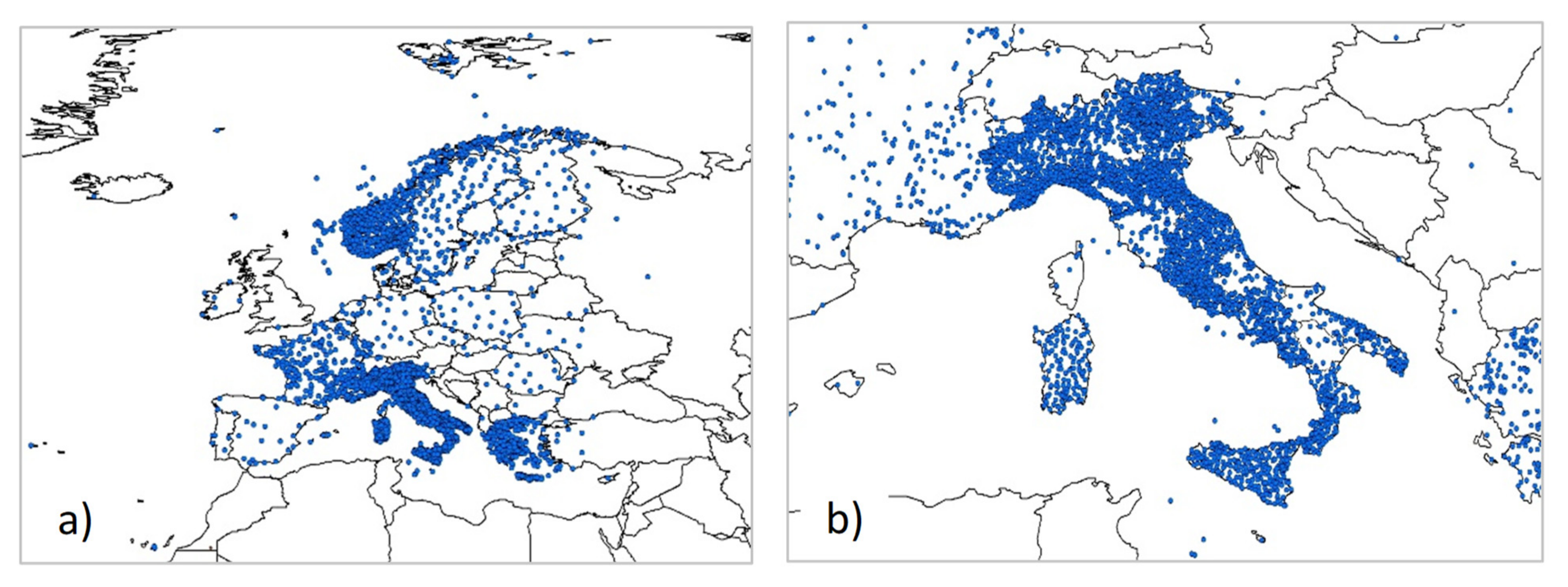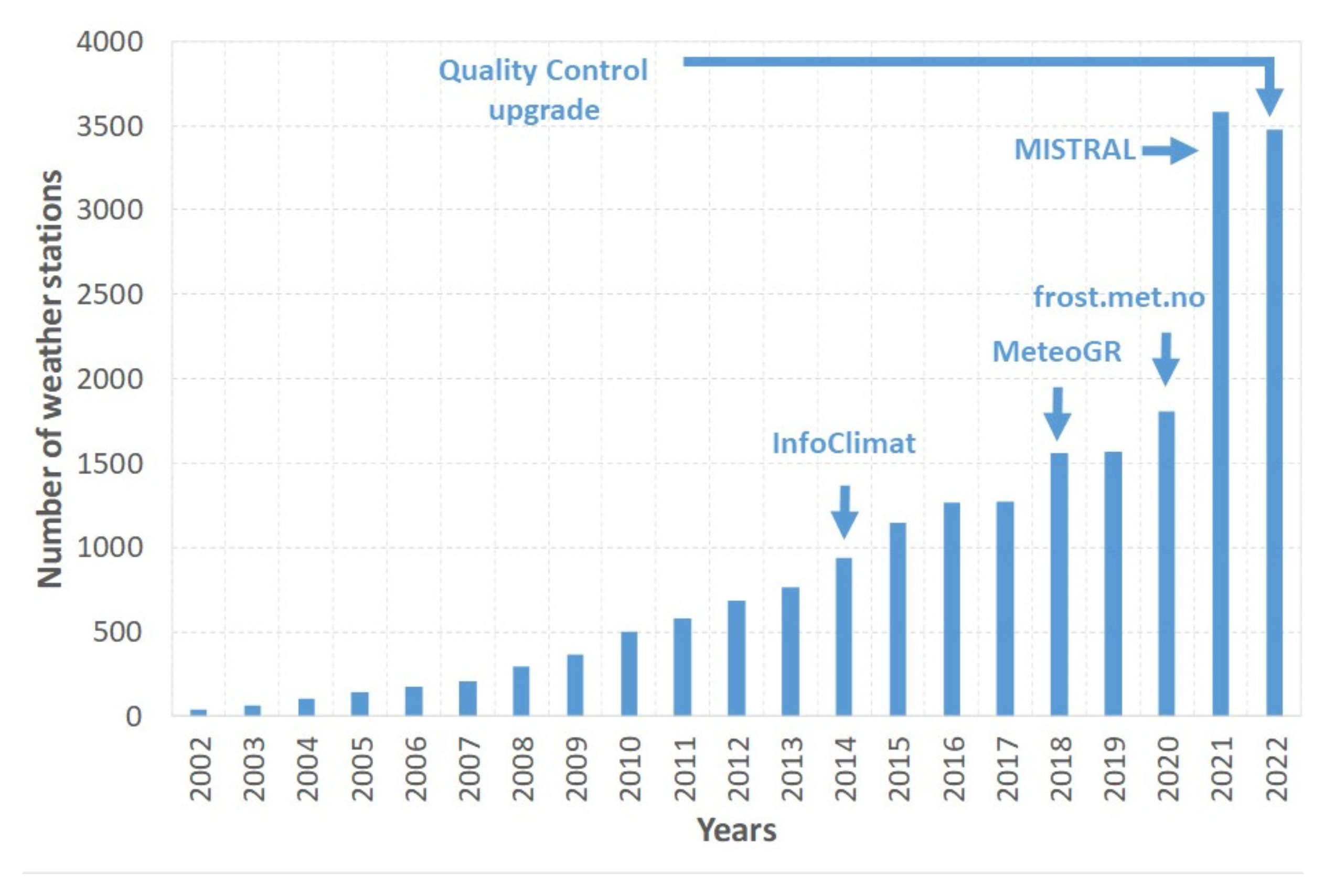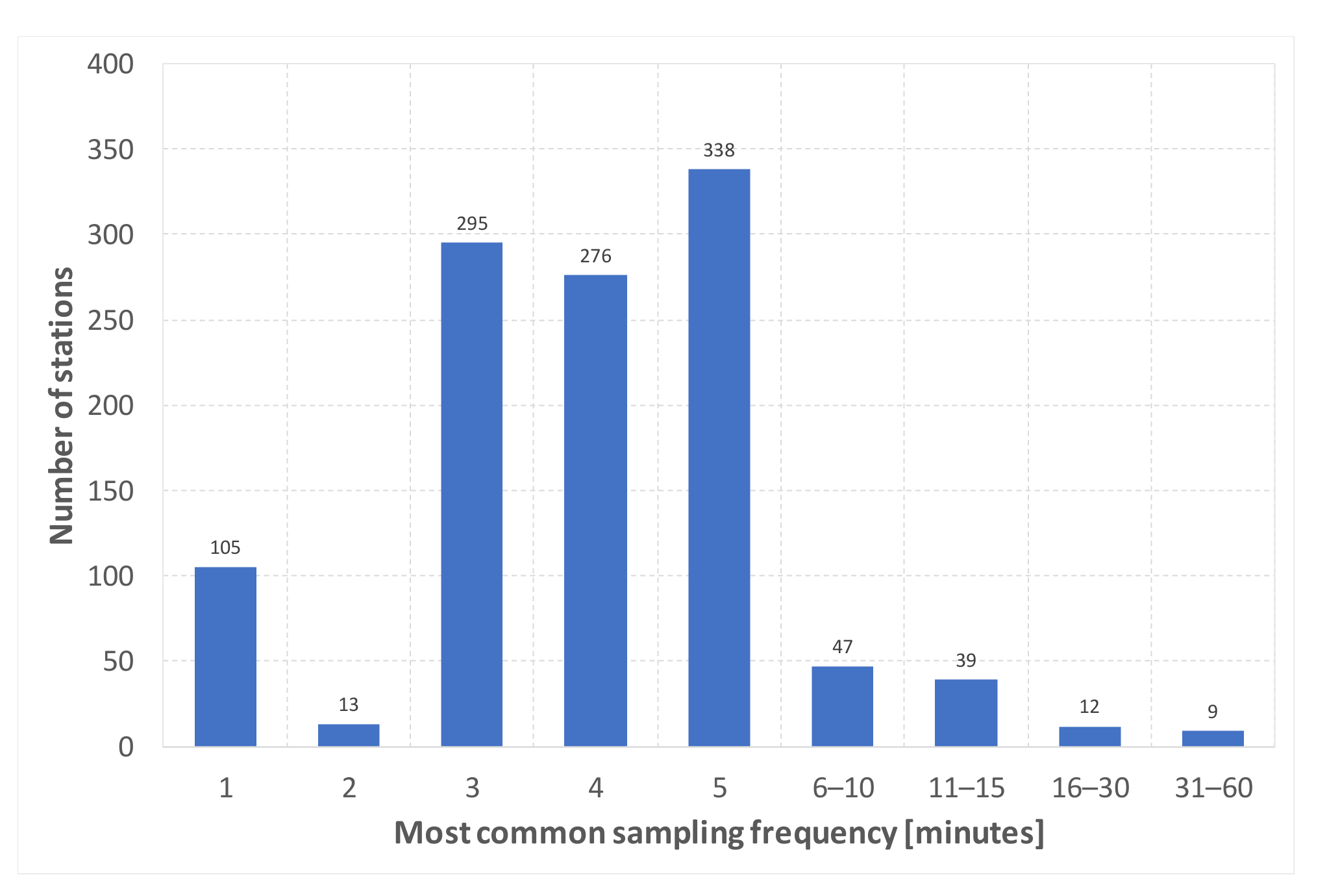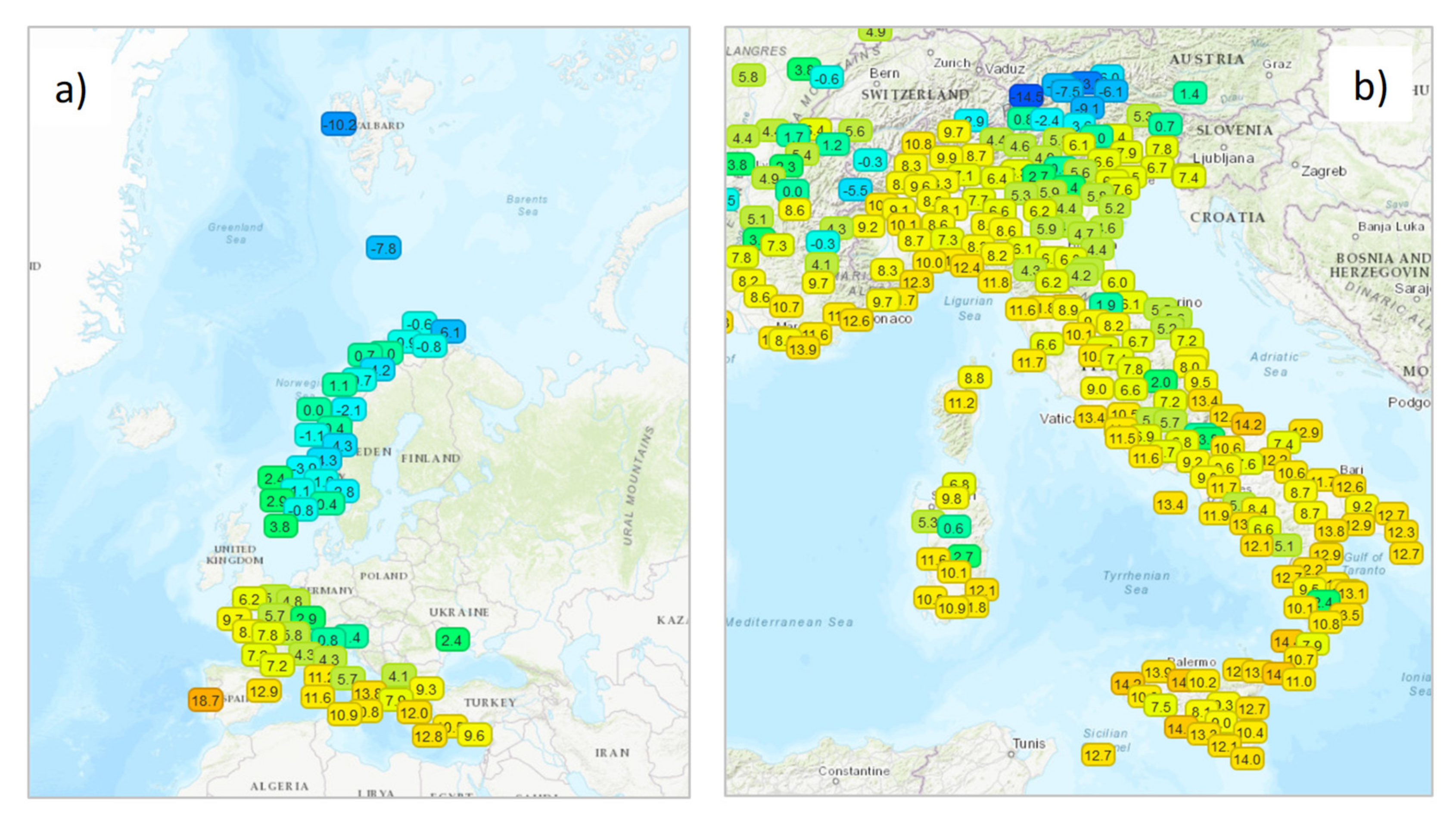Meteonetwork: An Open Crowdsourced Weather Data System
Abstract
:1. Introduction
1.1. Crowdsourcing and Amateur Weather Networks
1.2. The Origin and Mission of the Metonetwork Association
2. Materials and Methods
2.1. The Network Geographical Area
2.2. The Grow and the Actual Consistency of the Network
2.3. Guidelines and Metadata
2.3.1. Type of Siting
- -
- Rural: an extra-urban placement in areas where building density is very low or even absent, equivalent to LCZ A, B, C, and D. The location is not affected by the urban heat island effect and it includes, for example, countryside far from town, mountain installations, etc.
- -
- Suburban: a semi-urban placement in areas of low building density and abundance of pervious land covers and scattered trees, comparable to LCZ 5, 6, and 7. The urban heat island effect is low, e.g., residential areas far from cities.
- -
- Urban: an urban placement in areas of high building density, with land cover mostly paved and few or no trees, similar to LCZ 1, 2, 3, 4, and 9. The urban heat island effect is present, e.g., downtown, industrial areas, etc.
2.3.2. Sensors Layout
- (i)
- Open field: the weather station can be installed in an open field (e.g., countryside) with obstacles at least 10 m away from the station itself.
- (ii)
- Garden: weather sensors in gardens do not comply with all the requirements of the previous item; hence, they are accepted if obstacles are at least 4 m apart and their heights do not prevent an acceptable measurement.
- (iii)
- Courtyard: another option is to install the weather station in an area completely or partially enclosed by walls or buildings with further exceptions regarding the type of ground than the previous item (garden).
- (iv)
- Roof: this is one of the most critical installation places. In this case, the weather station must be installed at least 2 m above the roof surface and at a distance such that chimneys, air conditioning units, or other obstacles cannot influence the right measurement. This type of installation is similar to the historical meteorological observatories.
- (v)
- Balcony: usually, temperature and humidity sensors are installed separately from the rest of the weather station on a balcony or a terrace. In this case, there are additional limitations: sensors must be installed at least 1.50 m from the walls and at a distance such any obstacles cannot prevent a proper monitoring of the site.
- -
- An owner assessment, specifying in which type of area the weather station will be located (rural, suburban, and urban);
- -
- The choice for the best sensor layout based on the installation site, and compliance with related requirements, giving priority to temperature and humidity sensors;
- -
- Sending pictures of the weather station to the MNW team to check the necessary requirements;
- -
- Approval by the MNW committee and admission of the weather station into the network.
2.4. Information Technology Infrastructures
- -
- the WRF-ARW (Weather Research Forecasting–Advanced Research WRF) model processing and post-processing;
- -
- the post-processing of images for the WRF ensembles, GFS (Global Forecasting System), ECMWF (European for Medium range Weather Forecasts), and MOLOCH models.
Data Storage
- -
- identification of meteorological station ID and data source (by HTTP protocol);
- -
- identification of the interface to be used (depending on the format of data source and the software used by each collaborator). Currently, there are drivers for the following software/cloud archives: WeatherLink, WeatherLink IP, Cumulus, Anemos, WS2, Sint Wind PI, and there are automatic picking solutions to interface with the APIs of our partners, including Infoclimat, ARPA Veneto, Meteo Trentino, MeteoGr, and Mistral.
- -
- data download (daily archive or latest available data);
- -
- preliminary correction of errors (meteorological variables in a given min/max range, see Section 2.5 for further details);
- -
- identification of the reliability of single data (depending on the positioning of the weather station, the technical equipment, etc.);
- -
- data upload on the PostgreSQL database which has now reached a size of 600 GB, 450 of them only to archive raw weather station data.
2.5. Quality Control
- Range test: delete clear incorrect data (e.g., minimum temperatures below −40 °C, maximum temperatures above +50 °C, and rainfall below 0 mm);
- Cross-validation through percentiles: for each atmospheric variable and each station, the distribution of values measured by the 15 nearest stations in a maximum of 30 km range is analyzed in order to obtain the 10th and 90th percentiles. A tolerance is calculated using the standard deviation of the distribution, which is added to the 90th percentile and subtracted from the 10th percentile to obtain the cut-off values of the quality check. The use of standard deviation for the tolerance computation considers the natural variability of the variable in a specific weather situation: if this variability of the given variable is predominantly accentuated (high standard deviation), the boundaries are more relaxed and less stringent. In a situation where the natural variability of the variable field is very reduced, the tolerance is more rigorous, instead. A general check over the whole Italian domain with the same logic is performed only for the interpolated-map making process, in order to be aware to delete those outliers that might cause graphical issues. Data failing the QC are flagged, and do not enter in the maps elaboration process; however, they remain in the database.
Future Real-time Anomaly Detection System
3. Products and Discussion
3.1. Services
3.1.1. Live Data
3.1.2. Interpolated Maps
3.1.3. The Open-Source Policy
3.2. MNW Data Assimilation into the WRF Model
3.3. The Weatherness Project
4. Conclusions
Author Contributions
Funding
Institutional Review Board Statement
Informed Consent Statement
Data Availability Statement
Acknowledgments
Conflicts of Interest
References
- Wehn, U.; Gharesifard, M.; Ceccaroni, L.; Joyce, H.; Ajates, R.; Woods, S.; Bilbao, A.; Parkinson, P.; Gold, M.; Wheatland, J. Impact assessment of citizen science: State of the art and guiding principles for a consolidated approach. Sustain. Sci. 2021, 16, 1683–1699. [Google Scholar] [CrossRef]
- Strasser, B.J.; Baudry, J.; Maha, D.; Sanchez, G.; Taicogne, E. “Citizen Science”? Rethinking Science and Public Participation. Sci. Technol. Stud. 2019, 32, 52–76. [Google Scholar] [CrossRef]
- Rubio-Iglesias, J.M.; Edovald, T.; Grew, R.; Kark, T.; Kideys, A.E.; Peltola, T.; Volten, H. Citizen Science and Environmental Protection Agencies: Engaging Citizens to Address Key Environmental Challenges. Front. Clim. 2020, 2, 600998. [Google Scholar] [CrossRef]
- Wiggins, A.; Crowston, K. From conservation to crowdsourcing: A typology of citizen science. In Proceedings of the 2011 44th Hawaii International Conference on System Sciences, Kauai, HI, USA, 4–7 January 2011; pp. 1–10. [Google Scholar]
- Goodchild, M.F. Citizens as sensors: The world of volunteered geography. GeoJournal 2007, 69, 211–221. [Google Scholar] [CrossRef] [Green Version]
- Ceccaroni, L.; Bowser, A.; Brenton, P. Civic Education and Citizen Science: Definitions, Categories, Knowledge Representation. In Analyzing the Role of Citizen Science in Modern Research; Ceccaroni, L., Piera, J., Eds.; IGI: Hershey, PA, USA, 2017; pp. 1–23. [Google Scholar] [CrossRef]
- Howe, J. Crowdsourcing: A Definition. Wired Blog Network: Crowdsourcing. 2006. Available online: https://crowdsourcing.typepad.com/cs/2006/06/crowdsourcing_a.html (accessed on 15 May 2022).
- Dickinson, J.L.; Zuckerberg, B.; Bonter, D.N. Citizen science as an ecological research tool: Challenges and benefits. Annu. Rev. Ecol. Evol. Syst. 2010, 41, 149–172. [Google Scholar] [CrossRef] [Green Version]
- Muller, C.; Chapman, L.; Johnston, S.; Kidd, C.; Illingworth, S.; Foody, G.; Overeem, A.; Leigh, R. Crowdsourcing for climate and atmospheric sciences: Cur rent status and future potential. Int. J. Climatol. 2015, 35, 3185–3203. [Google Scholar] [CrossRef] [Green Version]
- Balázs, B.; Mooney, P.; Nováková, E.; Bastin, L.; Jokar Arsanjani, J. Data Quality in Citizen Science. In The Science of Citizen Science; Vohland, K., Land-Zandstra, A., Ceccaroni, L., Lemmens, R., Perelló, J., Ponti, M., Samson, R., Wagenknecht, K., Eds.; Springer: Cham, Switzerland, 2021; Chapter 8; pp. 139–157. [Google Scholar] [CrossRef]
- Fiebrich, C.A.; Morgan, C.R.; McCombs, A.G.; Hall, P.K.; McPherson, R.A. Quality assurance procedures for mesoscale meteorological data. J. Atmos. Ocean. Technol. 2010, 27, 1565–1582. [Google Scholar] [CrossRef]
- Lukyanenko, R.; Wiggins, A.; Rosser, H.K. Citizen Science: An Information Quality Research Frontier. Inf. Syst. Front. 2020, 22, 961–983. [Google Scholar] [CrossRef] [Green Version]
- GCOS. Implementation Plan for the Global Observing System for Climate in Support of the UNFCCC (2010 Update). GOOS-184, GTOS-76, WMO-TD/No. 1523. 2010. Available online: https://library.wmo.int/doc_num.php?explnum_id=3851 (accessed on 15 May 2022).
- Campbell, A.T.; Eisenman, S.B.; Lane, N.D.; Miluzzo, E.; Peterson, R.A. People-centric urban sensing. In Proceeding of the 2nd Annual International Workshop on Wireless Internet, WICON ’06, New York, NY, USA, 2–5 August 2006. [Google Scholar] [CrossRef]
- WMO. Guide to Instruments and Methods of Observation, Volume I—Measurement of Meteorological Variables (WMO-No. 8); World Meteorological Organization: Geneva, Switzerland, 2018; 573p, Available online: https://library.wmo.int/index.php?lvl=notice_display&id=12407#.Yjj6XjXSKHt (accessed on 15 May 2022).
- Stewart, I.D.; Oke, T.R. Local Climate Zones for Urban Temperature Studies. Bull. Am. Meteorol. Soc. 2012, 93, 1879–1900. [Google Scholar] [CrossRef]
- Cuff, D.; Hansen, M.; Kang, J. Urban sensing: Out of the woods. Commun. ACM 2008, 51, 24–33. [Google Scholar] [CrossRef]
- Muller, C.L.; Chapman, L.; Grimmond, C.S.B.; Young, D.T.; Cai, X. Toward a standardized metadata protocol for urban meteorological networks. Bull. Am. Meteorol. Soc. 2013, 94, 1161–1185. [Google Scholar] [CrossRef] [Green Version]
- Boulos, M.N.K.; Resch, B.; Crowley, D.N.; Breslin, J.G.; Sohn, G.; Burtner, R.; Pike, W.A.; Jezierski, E.; Chuang, K.-Y.S. Crowdsourcing, citizen sensing and sensor web technologies for public and environmental health surveillance and crisis management: Trends, OGC standards and application examples. Int. J. Health Geogr. 2011, 10, 67. [Google Scholar] [CrossRef] [PubMed] [Green Version]
- Sartori, M.; Avaldi, L.J.; Patruno, P. Studio Statistico Dell’impatto Della rete MeteoNetwork Sulla Stima di Parametri Meteo Superficiali in Emilia-Romagna. Agenzia Regionale per la Prevenzione e Protezione Ambientale dell’Emilia Romagna. 2016. Available online: https://www.meteonetwork.it/wp-content/uploads/2017/03/report.pdf (accessed on 15 May 2022). (In Italian).
- Ceschin, S. Due Fonti per le Stesse Informazioni: Confronti e Integrazione di reti di Stazioni Meteorologiche. Tesi di Laurea. 2017. Available online: http://tesi.cab.unipd.it/56467/1/Ceschin_Sara.pdf (accessed on 15 May 2022). (In Italian).
- Kim, H.-J.; Lee, H.S.; Choi, B.J.; Kim, Y.-H. Machine learning-based quality control and error correction using homogeneous temporal data collected by IoT sensors. J. Korea Converg. Soc. 2019, 10, 17–23. [Google Scholar] [CrossRef]
- Kim, H.-J.; Park, S.M.; Choi, B.J.; Moon, S.-K.; Kim, Y.-H. Spatiotemporal approaches for quality control and error correction of atmospheric data through machine learning. Comput. Intell. Neurosci. 2020, 2020, 7980434. [Google Scholar] [CrossRef] [PubMed] [Green Version]
- Narayan, S.S.; Marlin, B.M. Multi-Time Attention Networks for Irregularly Sampled Time Series. In Proceedings of the ICLR 2021, Conference Paper 881. Virtual, 3–7 May 2021; Available online: https://iclr.cc/Conferences/2021 (accessed on 15 May 2022).
- Ravazzani, G.; Ceppi, A.; Davolio, S. Wind speed interpolation for evapotranspiration assessment in complex topography area. Bull. of Atmos. Sci. Technol. 2020, 1, 13–22. [Google Scholar] [CrossRef] [Green Version]
- Dutton, J.A. The Ceaseless Wind, An Introduction to the Theory of Atmospheric Motion; McGraw-Hill: New York, NY, USA, 1976; p. XV+579. [Google Scholar] [CrossRef] [Green Version]
- Ceppi, A.; Ravazzani, G.; Corbari, C.; Salerno, R.; Meucci, S.; Mancini, M. Real-time drought forecasting system for irrigation management. Hydrol. Earth Syst. Sci. 2014, 18, 3353–3366. [Google Scholar] [CrossRef] [Green Version]
- Ravazzani, G.; Amengual, A.; Ceppi, A.; Homar, V.; Romero, R.; Lombardi, G.; Mancini, M. Potentialities of ensemble strategies for flood forecasting over the Milano urban area. J. Hydrol. 2016, 539, 237–253. [Google Scholar] [CrossRef]
- Lombardi, G.; Ceppi, A.; Ravazzani, G.; Davolio, S.; Mancini, M. From deterministic to probabilistic forecasts: The ‘shift-target’ approach in the Milan urban area (northern italy). Geosci. J. 2018, 8, 181. [Google Scholar] [CrossRef] [Green Version]
- Paciolla, N.; Corbari, C.; Al Bitar, A.; Kerr, Y.; Mancini, M. Irrigation and Precipitation Hydrological Consistency with SMOS, SMAP, ESA-CCI, Copernicus SSM1km, and AMSR-2 Remotely Sensed Soil Moisture Products. Remote Sens. 2020, 12, 3737. [Google Scholar] [CrossRef]
- Montoli, E.; Frustaci, G.; Lavecchia, C.; Pilati, S. High-resolution climatic characterization of air temperature in the urban canopy layer. Bull. Atmos. Sci. Technol. 2021, 2, 7. [Google Scholar] [CrossRef]
- Frustaci, G.; Pilati, S.; Lavecchia, C.; Montoli, E.M. High-Resolution Gridded Air Temperature Data for the Urban Environment: The Milan Data Set. Forecasting 2022, 4, 14. [Google Scholar] [CrossRef]
- Nipen, T.N.; Seierstad, I.A.; Lussana, C.; Kristiansen, J.; Hov, Ø. Adopting Citizen Observations in Operational Weather Prediction. Bull. Am. Meteorol. Soc. 2020, 101, E43–E57. [Google Scholar] [CrossRef]
- Madaus, L.E.; Hakim, G.J.; Mass, C.F. Utility of dense pressure observa tions for improving mesoscale analyses and forecasts. Mon. Wea. Rev. 2014, 142, 2398–2413. [Google Scholar] [CrossRef] [Green Version]
- Gasperoni, N.A.; Wang, X.; Brewster, K.A.; Carr, F.H. Assessing impacts of the high-frequency assimilation of surface observations for the forecast of convection initiation on 3 April 2014 within the Dalla–Fort Worth test bed. Mon. Wea. Rev. 2018, 146, 3845–3872. [Google Scholar] [CrossRef]
- Skamarock, W.C.; Klemp, J.B.; Dudhia, J.; Gill, D.O.; Liu, Z.; Berner, J.; Wang, W.; Powers, J.G.; Duda, M.G.; Barker, D.; et al. A Description of the Advanced Research WRF Model Version 4.3; (No. NCAR/TN-556+STR); National Center for Atmospheric Research: Boulder, CO, USA, 2021; p. 145. [Google Scholar] [CrossRef]
- Ferrier, B.S.; Jin, Y.; Lin, Y.; Black, T.; Rogers, E.; DiMego, G. Implementation of a New Grid-Scale Cloud and Precipitation Scheme in the NCEP Eta Model. In Proceedings of the 15th Conference on Numerical Weather Prediction, San Antonio, TX, USA, 12–16 August 2002; pp. 280–283. [Google Scholar]
- Iacono, M.J.; Delamere, J.S.; Mlawer, E.J.; Shephard, M.W.; Clough, S.A.; Collins, W.D. Radiative forcing by long-lived greenhouse gases: Calculations with the AER radiative transfer models. J. Geophys. Res. 2008, 113, D13103. [Google Scholar] [CrossRef]
- Mlawer, E.J.; Taubman, S.J.; Brown, P.D.; Iacono, M.J.; Clough, S.A. Radiative transfer for inhomogeneous atmosphere: RRTM, a validated correlated-k model for the longwave. J. Geophys. Res. 1997, 102, 16663–16682. [Google Scholar] [CrossRef] [Green Version]
- Hong, S.-Y.; Noh, Y.; Dudhia, J. A new vertical diffusion package with an explicit treatment of entrainment processes. Mon. Weather. Rev. 2006, 134, 2318–2341. [Google Scholar] [CrossRef] [Green Version]
- Jiménez, P.A.; Dudhia, J.; González-Rouco, J.F.; Montávez, J.P.; García-Bustamante, E.; Navarro, J.; Vilà-Gueraude Arellano, J.; Muñoz-Roldán, A. An evaluation of WRF’s ability to reproduce the surface wind over complex terrain based on typical circulation patterns. J. Geophys. Res. Atmos. 2013, 118, 7651–7669. [Google Scholar] [CrossRef] [Green Version]
- Chen, F.; Dudhia, J. Coupling an advanced land-surface/hydrology model with the Penn State/NCAR MM5 modeling system. Part I: Model description and implementation. Mon. Wea. Rev. 2001, 129, 569–585. [Google Scholar] [CrossRef] [Green Version]
- Ravazzani, G.; Corbari, C.; Ceppi, A.; Feki, M.; Mancini, M.; Ferrari, F.; Gianfreda, R.; Colombo, R.; Ginocchi, M.; Meucci, S.; et al. From (cyber)space to ground: New technologies for smart farming. Hydrol. Res. 2017, 48, 656–672. [Google Scholar] [CrossRef] [Green Version]
- WHO. Global Strategy on Health, Environment and Climate Change: The Transformation Needed to Improve Lives and Wellbeing Sustainably through Healthy Environments. 2020. Available online: https://apps.who.int/iris/handle/10665/331959 (accessed on 15 May 2022).
- De Freitas, C.R.; Grigorieva, E.A. A comprehensive catalogue and classification of human thermal climate indices. Int. J. Biometeorol. 2015, 59, 109–120. [Google Scholar] [CrossRef]
- Kliber, H.H. Environmental physiology and shelter engineering. LXVII. Thermal effects of various temperature-humidity combinations on Holstein cattle as measured by physiological responses. Res. Bull. Mo. Agric. 1964, 1964, 862. [Google Scholar]
- Scharlau, K. Einführung eines Schwülemasstabes und Abgrenzung von Schwülezonen durch Isohygrothermen. Erdkunde 1950, 4, 188–201. (In German) [Google Scholar] [CrossRef] [Green Version]
- Siple, P.A.; Passel, C.F. Measurements of dry atmospheric cooling in subfreezing temperatures. Proc. Amer. Phill. Soc. 1945, 89, 177–199. [Google Scholar] [CrossRef]
- Steadman, R.G. The assessment of sultriness. Part I: A temperature-humidity index based on human physiology and clothing science. J. Appl. Meteorol. 1979, 18, 861–873. [Google Scholar] [CrossRef] [Green Version]
- Pepi, W.J. The New Summer Simmer Index. In Proceedings of the International Audience at the 80th Annual Meeting of the American Meteorological Society (AMS), Long Beach, CA, USA, 11 January 2000. [Google Scholar]
- Thom, E.C. The Discomfort Index. Weatherwise 1959, 12, 57–61. [Google Scholar] [CrossRef]
- Heckman, C.J.; Liang, K.; Riley, M. Awareness, understanding, use, and impact of the UV index: A systematic review of over two decades of international research. Prev. Med. 2019, 123, 71–83. [Google Scholar] [CrossRef]
- Matzarakis, A. Weather and climate related information for tourism. Tour. Plan. Dev. 2006, 3, 99–115. [Google Scholar] [CrossRef]
- Bell, S.; Cornford, D.; Bastin, L. How good are citizen weather stations? Addressing a biased opinion. Weather 2015, 70, 75–84. [Google Scholar] [CrossRef] [Green Version]






| Country | Stations (N) | Owner |
|---|---|---|
| Italy | 4411 | MNW (2128)/other national bodies (2283) * |
| Norway | 866 | Frost |
| Greece | 444 | MeteoGR (336)/Frost (8)/MNW (2) |
| France | 367 | Infoclimat (321)/Frost (29)/MNW (17) |
| Sweden | 125 | Frost |
| Finland | 50 | Frost |
| Spain | 31 | Frost (18)/MNW (11)/Infoclimat (2) |
| Poland | 23 | Frost |
| Germany | 22 | Frost |
| Svalbard Islands (Norway) | 20 | Frost |
| Romania | 14 | Frost |
| Russia | 14 | Frost |
| Swiss | 14 | Infoclimat (5)/MNW (5)/Frost (4) |
| Denmark | 11 | Frost |
| Ukraine | 10 | Frost |
| Belgium | 9 | Frost (5)/Infoclimat (4) |
| Netherlands | 9 | Frost (6)/Infoclimat (3) |
| Turkey | 9 | Frost |
| Portugal | 8 | Frost (5)/Infoclimat (3) |
| Ireland | 6 | Frost |
| Republic of San Marino | 5 | MNW |
| Belarus | 4 | Frost |
| Czech Republic | 4 | Frost |
| Slovakia | 4 | Frost |
| Bulgaria | 3 | Frost |
| Brazil | 2 | MNW |
| Canada | 2 | Infoclimat |
| Latvia | 2 | Frost |
| Slovenia | 2 | Frost (1)/MNW (1) |
| Albania | 1 | MNW |
| Antarctica | 1 | Frost |
| Austria | 1 | MNW |
| Croatia | 1 | Frost |
| Cyprus | 1 | MeteoGR |
| Estonia | 1 | Frost |
| Greenland (Denmark) | 1 | Frost |
| Iceland | 1 | Frost |
| Kosovo | 1 | MNW |
| Lithuania | 1 | Frost |
| Luxembourg | 1 | Frost |
| Malta | 1 | Frost |
| Moldova | 1 | MNW |
| Serbia | 1 | Frost |
| United Kingdom | 1 | MNW |
| Total number of stations | 6506 |
| Network | Country | Stations (N) | % |
|---|---|---|---|
| MNW (citizen scientists) | Italy et al. | 2163 | 33 |
| MISTRAL | Italy | 1789 | 27 |
| Frost | Norway et al. | 1287 | 20 |
| MeteoGR | Greece et al. | 435 | 7 |
| Infoclimat | France et al. | 338 | 5 |
| ARPA Calabria | Italy | 163 | 3 |
| Meteo Trentino | Italy | 116 | 2 |
| Civil Protection of Bolzano Province | Italy | 84 | 1 |
| ARPA Veneto | Italy | 69 | 1 |
| ARPA Emilia-Romagna | Italy | 62 | 1 |
| Meteorological Variable | Sensors (N) | % |
|---|---|---|
| Precipitation | 6312 | 97 |
| Air temperature | 5926 | 91 |
| Air relative humidity | 4906 | 75 |
| Wind speed and direction | 4751 | 73 |
| Atmospheric pressure | 4410 | 68 |
| Solar radiation (global) | 1471 | 23 |
| UV radiation | 1132 | 17 |
| Sensor | Height above Ground (m) | Notes |
|---|---|---|
| Thermo-hygrometer | 1.7 ÷ 2.0 | The thermo-hygrometer must be housed in a certified radiation shield at a height above ground (a short grass or grass with not much gravel or sand surface) between 1.70 m and 2.00 m, or higher if necessary, to overcome hedges or other obstacles, and at least 4 m from the nearest building or obstacle. |
| Rain gauge | At least >0.50 | The rain gauge must be placed at least 4 m from the nearest obstacle, and at a distance such that any vertical barrier (tree, building) cannot prevent acceptable measurement in case of oblique precipitation. The rain gauge can also be separately placed on the roof. |
| Anemometer | Variable | The anemometer must be placed at a height such that any vertical obstacle cannot prevent acceptable measurement of gusts. The influence of turbulence should be considered as well. The anemometer can also be separately placed on the roof. |
| Solar and UV radiation | - | The sensors must be placed so that they are never in the shade throughout the day; even these sensors can be separately placed on the roof. |
Publisher’s Note: MDPI stays neutral with regard to jurisdictional claims in published maps and institutional affiliations. |
© 2022 by the authors. Licensee MDPI, Basel, Switzerland. This article is an open access article distributed under the terms and conditions of the Creative Commons Attribution (CC BY) license (https://creativecommons.org/licenses/by/4.0/).
Share and Cite
Giazzi, M.; Peressutti, G.; Cerri, L.; Fumi, M.; Riva, I.F.; Chini, A.; Ferrari, G.; Cioni, G.; Franch, G.; Tartari, G.; et al. Meteonetwork: An Open Crowdsourced Weather Data System. Atmosphere 2022, 13, 928. https://doi.org/10.3390/atmos13060928
Giazzi M, Peressutti G, Cerri L, Fumi M, Riva IF, Chini A, Ferrari G, Cioni G, Franch G, Tartari G, et al. Meteonetwork: An Open Crowdsourced Weather Data System. Atmosphere. 2022; 13(6):928. https://doi.org/10.3390/atmos13060928
Chicago/Turabian StyleGiazzi, Marco, Gianandrea Peressutti, Luca Cerri, Matteo Fumi, Isabella Francesca Riva, Andrea Chini, Gianluca Ferrari, Guido Cioni, Gabriele Franch, Gianni Tartari, and et al. 2022. "Meteonetwork: An Open Crowdsourced Weather Data System" Atmosphere 13, no. 6: 928. https://doi.org/10.3390/atmos13060928
APA StyleGiazzi, M., Peressutti, G., Cerri, L., Fumi, M., Riva, I. F., Chini, A., Ferrari, G., Cioni, G., Franch, G., Tartari, G., Galbiati, F., Condemi, V., & Ceppi, A. (2022). Meteonetwork: An Open Crowdsourced Weather Data System. Atmosphere, 13(6), 928. https://doi.org/10.3390/atmos13060928








